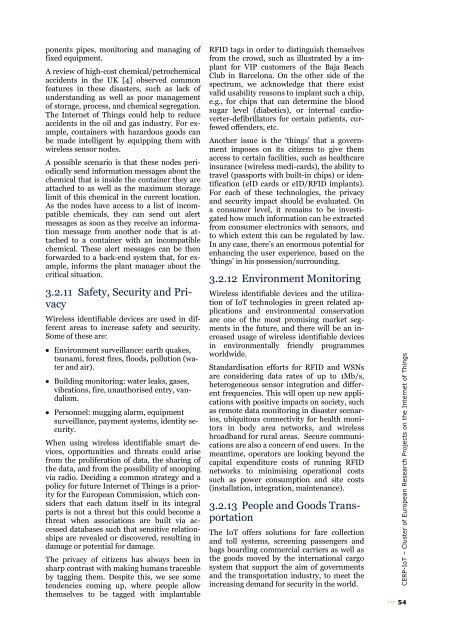Vision and Challenges for Realising the Internet of Things
Vision and Challenges for Realising the Internet of Things
Vision and Challenges for Realising the Internet of Things
Create successful ePaper yourself
Turn your PDF publications into a flip-book with our unique Google optimized e-Paper software.
ponents pipes, monitoring <strong>and</strong> managing <strong>of</strong><br />
fixed equipment.<br />
A review <strong>of</strong> high-cost chemical/petrochemical<br />
accidents in <strong>the</strong> UK [4] observed common<br />
features in <strong>the</strong>se disasters, such as lack <strong>of</strong><br />
underst<strong>and</strong>ing as well as poor management<br />
<strong>of</strong> storage, process, <strong>and</strong> chemical segregation.<br />
The <strong>Internet</strong> <strong>of</strong> <strong>Things</strong> could help to reduce<br />
accidents in <strong>the</strong> oil <strong>and</strong> gas industry. For example,<br />
containers with hazardous goods can<br />
be made intelligent by equipping <strong>the</strong>m with<br />
wireless sensor nodes.<br />
A possible scenario is that <strong>the</strong>se nodes periodically<br />
send in<strong>for</strong>mation messages about <strong>the</strong><br />
chemical that is inside <strong>the</strong> container <strong>the</strong>y are<br />
attached to as well as <strong>the</strong> maximum storage<br />
limit <strong>of</strong> this chemical in <strong>the</strong> current location.<br />
As <strong>the</strong> nodes have access to a list <strong>of</strong> incompatible<br />
chemicals, <strong>the</strong>y can send out alert<br />
messages as soon as <strong>the</strong>y receive an in<strong>for</strong>mation<br />
message from ano<strong>the</strong>r node that is attached<br />
to a container with an incompatible<br />
chemical. These alert messages can be <strong>the</strong>n<br />
<strong>for</strong>warded to a back-end system that, <strong>for</strong> example,<br />
in<strong>for</strong>ms <strong>the</strong> plant manager about <strong>the</strong><br />
critical situation.<br />
3.2.11 Safety, Security <strong>and</strong> Privacy<br />
Wireless identifiable devices are used in different<br />
areas to increase safety <strong>and</strong> security.<br />
Some <strong>of</strong> <strong>the</strong>se are:<br />
Environment surveillance: earth quakes,<br />
tsunami, <strong>for</strong>est fires, floods, pollution (water<br />
<strong>and</strong> air).<br />
Building monitoring: water leaks, gases,<br />
vibrations, fire, unauthorised entry, v<strong>and</strong>alism.<br />
Personnel: mugging alarm, equipment<br />
surveillance, payment systems, identity security.<br />
When using wireless identifiable smart devices,<br />
opportunities <strong>and</strong> threats could arise<br />
from <strong>the</strong> proliferation <strong>of</strong> data, <strong>the</strong> sharing <strong>of</strong><br />
<strong>the</strong> data, <strong>and</strong> from <strong>the</strong> possibility <strong>of</strong> snooping<br />
via radio. Deciding a common strategy <strong>and</strong> a<br />
policy <strong>for</strong> future <strong>Internet</strong> <strong>of</strong> <strong>Things</strong> is a priority<br />
<strong>for</strong> <strong>the</strong> European Commission, which considers<br />
that each datum itself in its integral<br />
parts is not a threat but this could become a<br />
threat when associations are built via accessed<br />
databases such that sensitive relationships<br />
are revealed or discovered, resulting in<br />
damage or potential <strong>for</strong> damage.<br />
The privacy <strong>of</strong> citizens has always been in<br />
sharp contrast with making humans traceable<br />
by tagging <strong>the</strong>m. Despite this, we see some<br />
tendencies coming up, where people allow<br />
<strong>the</strong>mselves to be tagged with implantable<br />
RFID tags in order to distinguish <strong>the</strong>mselves<br />
from <strong>the</strong> crowd, such as illustrated by a implant<br />
<strong>for</strong> VIP customers <strong>of</strong> <strong>the</strong> Baja Beach<br />
Club in Barcelona. On <strong>the</strong> o<strong>the</strong>r side <strong>of</strong> <strong>the</strong><br />
spectrum, we acknowledge that <strong>the</strong>re exist<br />
valid usability reasons to implant such a chip,<br />
e.g., <strong>for</strong> chips that can determine <strong>the</strong> blood<br />
sugar level (diabetics), or internal cardioverter-defibrillators<br />
<strong>for</strong> certain patients, curfewed<br />
<strong>of</strong>fenders, etc.<br />
Ano<strong>the</strong>r issue is <strong>the</strong> ‘things’ that a government<br />
imposes on its citizens to give <strong>the</strong>m<br />
access to certain facilities, such as healthcare<br />
insurance (wireless medi-cards), <strong>the</strong> ability to<br />
travel (passports with built-in chips) or identification<br />
(eID cards or eID/RFID implants).<br />
For each <strong>of</strong> <strong>the</strong>se technologies, <strong>the</strong> privacy<br />
<strong>and</strong> security impact should be evaluated. On<br />
a consumer level, it remains to be investigated<br />
how much in<strong>for</strong>mation can be extracted<br />
from consumer electronics with sensors, <strong>and</strong><br />
to which extent this can be regulated by law.<br />
In any case, <strong>the</strong>re’s an enormous potential <strong>for</strong><br />
enhancing <strong>the</strong> user experience, based on <strong>the</strong><br />
‘things’ in his possession/surrounding.<br />
3.2.12 Environment Monitoring<br />
Wireless identifiable devices <strong>and</strong> <strong>the</strong> utilization<br />
<strong>of</strong> IoT technologies in green related applications<br />
<strong>and</strong> environmental conservation<br />
are one <strong>of</strong> <strong>the</strong> most promising market segments<br />
in <strong>the</strong> future, <strong>and</strong> <strong>the</strong>re will be an increased<br />
usage <strong>of</strong> wireless identifiable devices<br />
in environmentally friendly programmes<br />
worldwide.<br />
St<strong>and</strong>ardisation ef<strong>for</strong>ts <strong>for</strong> RFID <strong>and</strong> WSNs<br />
are considering data rates <strong>of</strong> up to 1Mb/s,<br />
heterogeneous sensor integration <strong>and</strong> different<br />
frequencies. This will open up new applications<br />
with positive impacts on society, such<br />
as remote data monitoring in disaster scenarios,<br />
ubiquitous connectivity <strong>for</strong> health monitors<br />
in body area networks, <strong>and</strong> wireless<br />
broadb<strong>and</strong> <strong>for</strong> rural areas. Secure communications<br />
are also a concern <strong>of</strong> end users. In <strong>the</strong><br />
meantime, operators are looking beyond <strong>the</strong><br />
capital expenditure costs <strong>of</strong> running RFID<br />
networks to minimising operational costs<br />
such as power consumption <strong>and</strong> site costs<br />
(installation, integration, maintenance).<br />
3.2.13 People <strong>and</strong> Goods Transportation<br />
The IoT <strong>of</strong>fers solutions <strong>for</strong> fare collection<br />
<strong>and</strong> toll systems, screening passengers <strong>and</strong><br />
bags boarding commercial carriers as well as<br />
<strong>the</strong> goods moved by <strong>the</strong> international cargo<br />
system that support <strong>the</strong> aim <strong>of</strong> governments<br />
<strong>and</strong> <strong>the</strong> transportation industry, to meet <strong>the</strong><br />
increasing dem<strong>and</strong> <strong>for</strong> security in <strong>the</strong> world.<br />
CERP-IoT – Cluster <strong>of</strong> European Research Projects on <strong>the</strong> <strong>Internet</strong> <strong>of</strong> <strong>Things</strong><br />
54
















